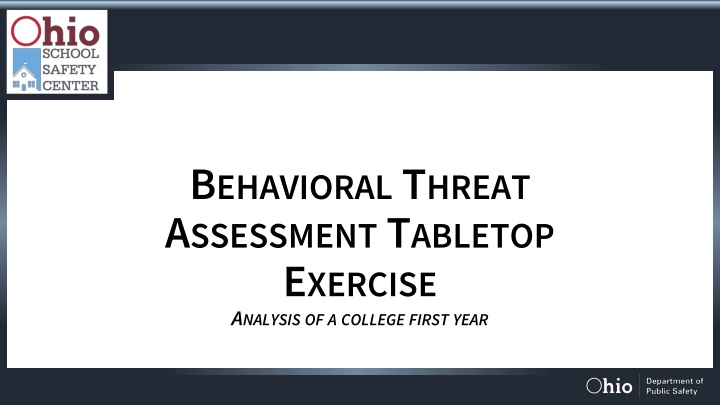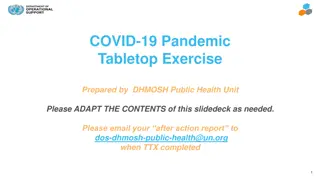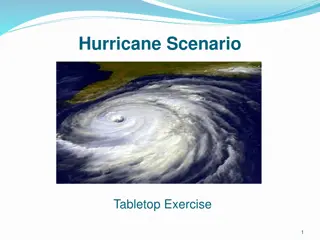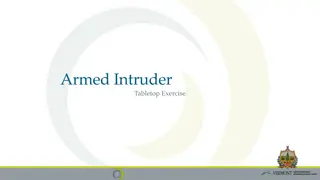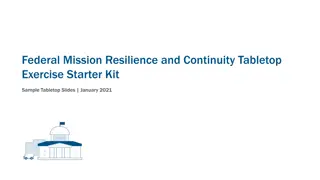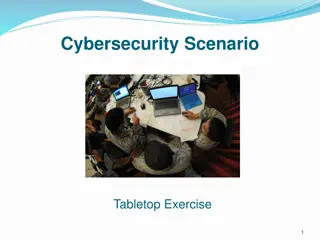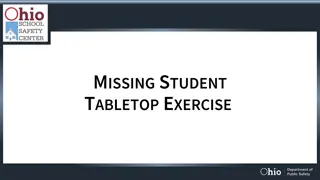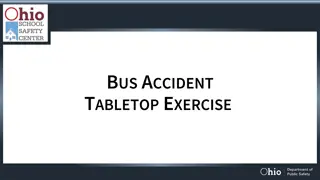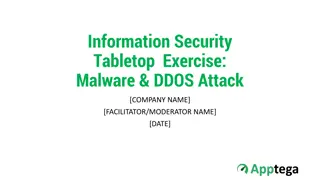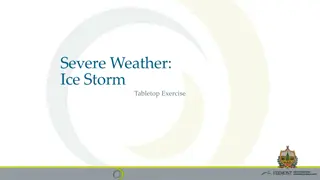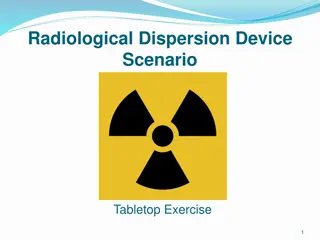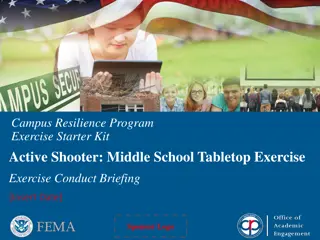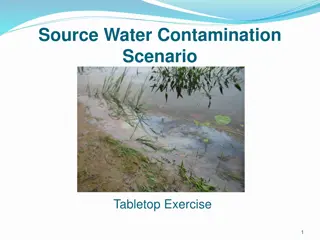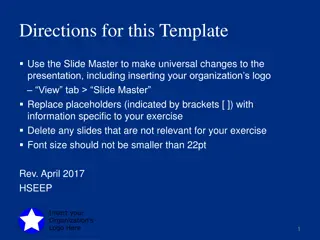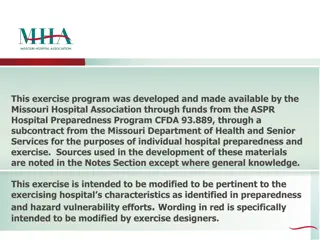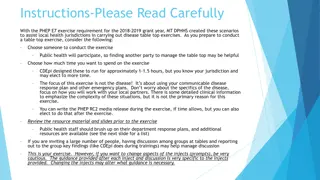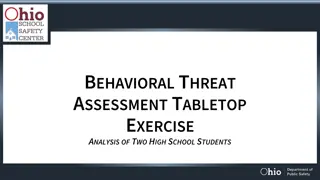Behavioral Threat Assessment Tabletop Exercise - College First Year Analysis
Explore a comprehensive behavioral threat assessment tabletop exercise focused on analyzing a college first-year scenario. The exercise includes roles and responsibilities for players, facilitators, evaluators, and observers, guiding participants through phases to familiarize themselves with a student, share information, and plan responses. The goal is to enhance threat assessment team discussions and preparation for real-world scenarios.
Download Presentation

Please find below an Image/Link to download the presentation.
The content on the website is provided AS IS for your information and personal use only. It may not be sold, licensed, or shared on other websites without obtaining consent from the author.If you encounter any issues during the download, it is possible that the publisher has removed the file from their server.
You are allowed to download the files provided on this website for personal or commercial use, subject to the condition that they are used lawfully. All files are the property of their respective owners.
The content on the website is provided AS IS for your information and personal use only. It may not be sold, licensed, or shared on other websites without obtaining consent from the author.
E N D
Presentation Transcript
BEHAVIORAL THREAT ASSESSMENTTABLETOP EXERCISE ANALYSIS OF A COLLEGE FIRST YEAR
THREAT ASSESSMENT TABLETOP EXERCISE Welcome & Introductions SLIDE 2
ROLESAND RESPONSIBILITIES Players Represent your role & discuss your planned response to the scenario Facilitators Moderate the flow of discussion. Keep the tabletop exercise moving and on-track Evaluators Record strengths, note areas of improvement, and capture lessons learned Observers Gain insight from the exercise. Refrain from interjecting during the exercise & be respectful SLIDE 3
NOTETOTHE FACILITATOR DELETE THIS SLIDE BEFORE USING THIS TABLETOP EXERCISE WITH YOUR THREAT ASSESSMENT TEAM. These are the instructions on how to set up this exercise: 1. Determine who the players, facilitators, evaluators, and observers will be during the exercise. 2. Edit/customize slides 9-15 to fit the threat assessment team roles that make sense for your school. Once this is done, print these slides for distribution during the exercise to the appropriate individuals. Also print the document in the link on slide 18 for use during the After- Action Report section of this exercise. 3. View slides 5-8 with your team to get the exercise started. 4. Distribute slides 9-15 to the appropriate individuals and have them familiarize themselves with their information. At this time, they can answer question 1 individually. 5. Reconvene group discussion, by having the team discuss everything they individually know about the student. Have them answer question 2 together. 6. Display slide 16. The assessment portion will begin, where the team should discuss how to move forward with the student and what resources for referral might be appropriate. Answer question 3. 7. Complete the After-Action Report document (in the link on slide 18) as a team. 8. Debrief, using the questions in the what did you discover slide (19) as a guide. Take this time to reflect on everything you did today and what you can do moving forward. SLIDE 4
EXERCISE ITINERARY Welcome and Introductions Goal and Purpose Exercise Set Up and Scenario explained Phase 1: Familiarize yourself with the student. (Answer question #1 individually) Phase 2: Share what you know about this student and create a total picture. (Answer question #2 through group discussion) Phase 3: What s next? (Answer question #3 through group discussion) After Action Report What did you Discover? SLIDE 5
GOALAND PURPOSE The goal of this tabletop exercise is to start/continue conversations with our Threat Assessment Team and provide a real-world scenario that will simulate the information that could/would be available to you in an actual event. SLIDE 6
SET UP Ben is a hypothetical 1st year student that attends Your School Name Here Based on the information you are given decide the following: 1. Looking at only your information, is Ben a potential threat? 2. Looking at the information the Threat Assessment Team has gathered, is Ben a potential threat? 3. What would be the next steps your team would take? SLIDE 7
SCENARIO Phase 1: Each team member will receive individual information. Read this information separately and determine if a threat assessment is needed. (answer question #1) Phase 2: Next, each member will share their information with the team. As a team, determine if a threat assessment is needed. (answer question #2) Phase 3: If an assessment is needed, please make a plan for the next steps. (answer question #3) SLIDE 8
COLLEGE INFORMATION The university has no knowledge of any prior issues that Ben has had with mental health or any issues with law enforcement. He passed through the routine background check the university does as a part of the application process. SLIDE 9
CAMPUS MENTAL HEALTH INFORMATION Received a phone call from the Resident Advisor (RA) of Ben s dormitory asking that they get in touch with the student. No specific concerns were mentioned. Called and talked to Ben on the phone. Campus Mental Health scheduled an appointment for him to come in and talk. Failed to show up to his scheduled appointment. SLIDE 10
PARENT INFORMATION Ben s parents emailed the university s First Year Advisor with concerns about how he was handling the transition to college. They have yet to receive a response. SLIDE 11
LAW ENFORCEMENT INFORMATION Ben s professor called police to report a potential threat made against her by Ben. Campus police tried to get ahold of Ben using the contact information available in his student file. He did not answer his phone. Campus police report to Ben s dorm room for a welfare check. His roommate lets police into the room to look around. There they see several items of drug paraphernalia. The roommate alleges it belongs to Ben. Police locate Ben driving his vehicle on campus. When they initiate a traffic stop, they locate a loaded handgun sitting on the front seat. SLIDE 12
ROOMMATE INFORMATION Starts to notice that Ben has been very isolated and is sleeping all the time. Ben will no longer go to social gatherings on campus with him. Went to the Resident Advisor (RA) to complain about Ben s hygiene and uncleanliness. SLIDE 13
PROFESSOR INFORMATION Ben has missed numerous classes and assignments during the semester. Receives a phone call from Ben asking to arrange a different time to take an upcoming exam. The professor tells Ben, you are going to fail the class, the exam will not help you at this point, it s too late and there is nothing that can be done to change it. To this statement, Ben in a very threatening way says, we will see about that. SLIDE 14
PERSONAL (ONLY BEN KNOWS) INFORMATION Ben has dealt with feelings of isolation and like the world is against him since high school. Had a threat assessment completed on him by his high school due to concerns of him carrying out an act of violence against a teacher. SLIDE 15
THE TOTAL PICTUREOF BEN College Parent Law Enforcement Campus Mental Health Professor Roommate Ben No knowledge of mental health or law enforcement encounters. Struggling to transition to college Potential threat made towards professor Received referral from RA Failing the class due to absence and not completing work Isolation and sleeping all the time Feels isolated and like the world is against him Passed through application process without issue Unreachable on his phone Scheduled appointment for evaluation Feels threatened by statements made on phone No longer goes to social gatherings Subject of threat assessment in HS Find drug paraphernalia in dorm room Did not come to his appointment Poor hygiene and messy Driving with loaded handgun SLIDE 16
REFLECTION The categories across the top represent each of the different individuals/groups that have contact with Ben. Information from one of those entities may not be overly concerning, but once we put the total picture together, a potential threat emerges. SLIDE 17
AFTER ACTION REPORT After Action Improvement Plan Template Note: click the above link and use pages 2-4 for your after action report SLIDE 18
WHAT DID YOU DISCOVER? What did you discover during your After-Action Review? Does any part of your threat assessment process or practices need altered? Is additional training warranted to facilitate the proper execution of this process? Do we need to look at gathering more resources for educational, training, or referral purposes in the event this actually occurred at our school? If any of the answers to the above questions are, "yes", identify who will be responsible and the timeline to make the changes identified. SLIDE 19
